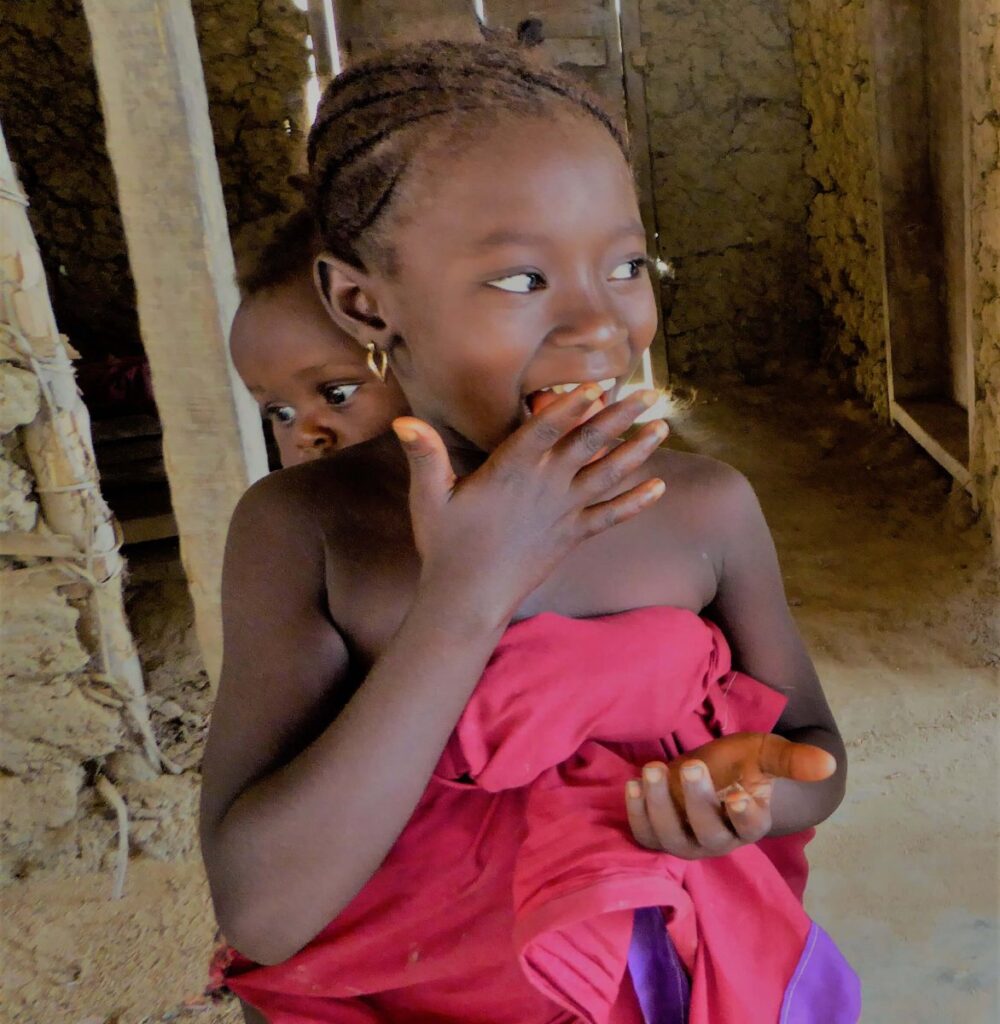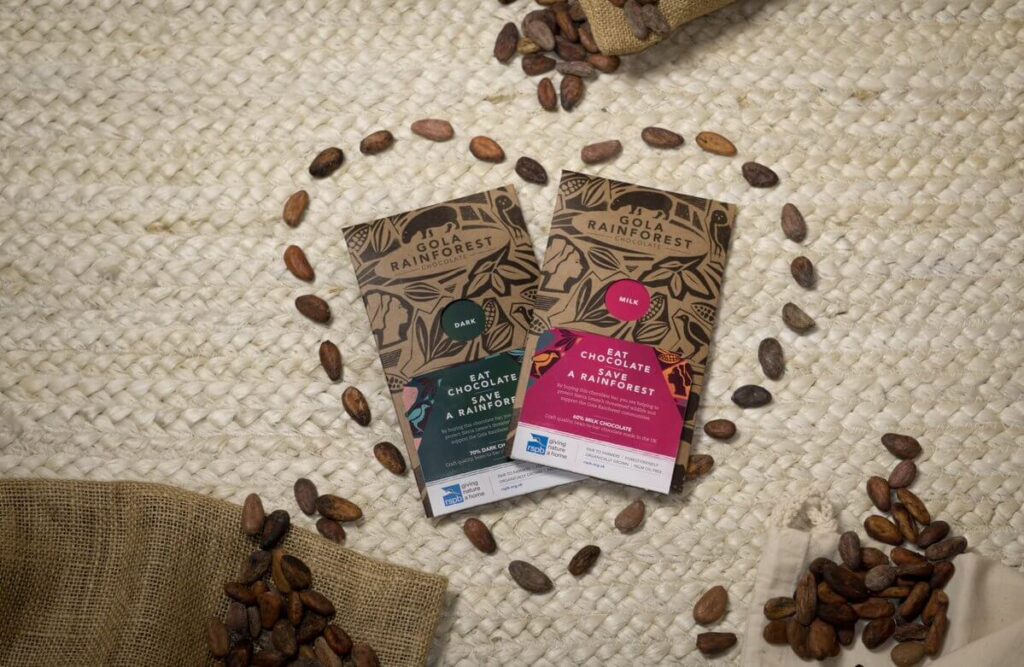Eat chocolate, save a rainforest – the Gola Cocoa Project tells you how

Sounds too good to be true? A project is stopping deforestation and community exploitation in Sierra Leone through the power of cocoa.
Sounds too good to be true? A project is stopping deforestation and community exploitation in Sierra Leone through the power of cocoa.
New for World Chocolate Day 2020: see how the Goleagorbu people of Sierra Leone are working to make a living out of protecting the rainforest:
Gbessay Sannoh and Bockerie Sama are standing in a shady rainforest amongst the whooping sounds of hornbills and leafy cocoa trees. They’re at the edge of the Gola Rainforest in Sierra Leone, where for generations thousands of cocoa trees have been grown by their people – the Goleagorbu, small-scale farmers. While chatting and joking they break open the large, golden-yellow cocoa pods with smooth-handled wooden clubs.
Inside the pod, what looks like rows of white teeth are revealed. This is cocoa’s sweet mucilage, which is then removed by sticky hands to expose the prize beneath: the beans. These then go into large woven baskets or wooden boxes and are covered with banana leaves, where they are left to ferment, releasing the sugars which will make the eventual chocolate so tasty.
But until recently, 24,000 farmers in this area didn’t even know what chocolate was. In the past, their cocoa was exported in bulk commodity supply chains – meaning they had no idea where their beans ended up, let alone ever tasting the final luxury, global product (of which they would receive a disgraceful three to six per cent of a bar’s value). And not only that, but this cocoa production was not sustainable, and was contributing to a catastrophic loss of rainforest.
The Upper Guinean Tropical Rainforest (which borders Liberia and Sierra Leone, two of the poorest countries in the world) used to be full of wildlife. Exploitation of this lush forest has led to vast tracts being lost to intensive agriculture (including cash crops like cocoa), mining and logging, bringing serious threats to species like Pygmy Hippopotamus Choeropsis liberiensis, Western Chimpanzee Pan troglodytes verus (both Endangered) and White-necked Rockfowl Picathartes gymnocephalus (Vulnerable), not to mention the livelihoods of the people who rely on the forest.
However, in the largest remaining fragment, a flagship conservation effort is also found: the Gola Rainforest National Park (GRNP). The park was established seven years ago in a partnership between the Conservation Society of Sierra Leone (BirdLife Partner), Sierra Leone’s government, BirdLife International, the RSPB (BirdLife in the UK), and 140,000 Goleagorbu living in Gola’s forest edge. How could the protection of the Gola Rainforest become a serious business for the Goleagorbu people? One of the solutions has been found in cocoa.
Is deforestation-free chocolate a myth? Across many parts of the world there has been a lack of investment in sustainable cocoa. This not only perpetuates high levels of poverty, but it also drives tropical forest loss, as farmers slash-and-burn new areas for planting more cocoa to support themselves. This, along with the development of sun-tolerant cocoa hybrids – which allow for more intensive, full-sun plantations – has driven significant tropical forest clearance in the main West African cocoa-growing countries of an estimated 2.3 million hectares between 1988 and 2007. And the ultimate driver for this is our love of chocolate.
So in 2015, we started to build a cocoa business with the ability to protect the Gola Rainforest. Cocoa farmers on the forest-edge, like Gbessay and Bockerie, came together to form the Goleagorbu Cocoa Producers Organization (GCPO), the foundation of the business. It’s founded on democratic principles where farmers register, pay subscription fees and elect leaders to manage their pot of money. Together, we have been investing in forest-friendly cocoa that will bring long-term returns to the Goleagorbu people.
By Katie Sims & Shaun Hurrell


The Gola Cocoa team have supported farmers with training in a technique called agroforestry, whereby cocoa trees are strategically planted alongside leafy shade trees which birds love, nitrogen-fixing trees for soil fertility, bushes of pineapples and chilli peppers, and tendrils of maize. From these forest-edge smallholdings, the Goleagorbu farmers take the cocoa and process in groups, then together take cocoa to the new Buying Centres.
Each centre is equipped with scales, a receipt book and a published price for cocoa per kilo. It may sound simple but farmers had not seen this level of transparency before. As Juma Koroma, one of the Treasurers at GCPO, explains: “I used to sell cocoa to other traders in the area. Traders would often cheat us; they never allowed the scales to face me, so I couldn’t see the weight of my cocoa and had no idea what price I should expect. I have now learnt to read the scales myself and know what I deserve for my cocoa.”
Profits from the first container of cocoa sold went 75% to the farmers and 25% back into the organization
In the village of Lalehun, members have already saved enough to start a credit scheme, which makes a small amount of interest to invest back into the Organization. The Gola Cocoa team have supported the elected leaders to become strong representatives, and 27% are women. A programme of training for youth Master Farmers also encourages knowledge to be shared with future generations.
Globally, industry is also waking up to cocoa-driven deforestation, and recent announcements from the 12 biggest cocoa companies herald a commitment to “zero deforestation cocoa supply chains”. In a similar vein, our work at Gola is also a flagship for our exciting venture, Trillion Trees (with WCS and WWF), that boldly aims to end deforestation by 2050, such as by scaling-up proven projects like this to other parts of the tropics.
In Gola, the next step for the farmers is to sell their quality Gola Rainforest Cocoa to to more high value markets in Europe and the USA and gain further certifications to increase their market access.
“I used to sell cocoa to other traders in the area. Traders would often cheat us; they never allowed the scales to face me, so I couldn’t see the weight of my cocoa and had no idea what price I should expect. I have now learnt to read the scales myself and know what I deserve for my cocoa.”
Juma Koroma, Treasurer at the GCPO

What is our next step in making this business work? The development of our own Gola Rainforest Chocolate bar. “We’re exploring with chocolate makers what’s possible for our own-brand bar,” says Alice Ward-Francis, Senior Forests Programme Officer, BirdLife. “We want to show the world that Sierra Leonean cocoa can taste amazing whilst protecting rainforest.”
Some of the first batch of pilot bars were taken by the RSPB for the Goleagorbu farmers to try chocolate for the first time. Aminata Berewa, supervisor of the cocoa team, remembers: “The look on their faces was total surprise! They enjoyed tasting it, discovering the flavour, especially knowing it was their own cocoa in the bar”.
With deforestation reduced and 2,000 people empowered, the taste is doubly delicious.
How to: produce forest & farmer-friendly cocoa

- Start a democratic organisation – The Goleagorbu Cocoa Producers Organization improves cocoa quality, together, which can give them access to a better price – without encroaching forest.
- Agroforestry (crops among shade trees) – Optimises production in a smaller space and is better for biodiversity than traditional farming. It also provides food for the family and an alternative crop to sell locally.
- Process cocoa in one place in community groups – Access to facilities can increase efficiency, involves even farmers with small production, and brings consistency to the cocoa quality.
- Form buying centres in villages – Run by elected buying officers trained to buy high-quality cocoa, they ensure people aren’t cheated and get a better price for their cocoa.
Like what you see? Buy Gola Chocolate here!

The RSPB and Gola Rainforest National Park project is partnered with Divine Chocolate Ltd and supported by the sustainable trade initiative Cocoa Origins Program (IDH).
www.rspb.org.uk/about-the-rspb/at-home-and-abroad/international/tropical-forests/greater-gola/
www.trilliontrees.org/landscape-venture/gola
www.standfortrees.org/protect-a-forest/gola
For more information, please contact: [email protected]
Stay up to date
Sign up to receive the latest bird conservation news. You’ll also receive updates about our projects, science and other ways to get involved including fundraising.
Thank you for your support, we are committed to protecting your personal information and privacy. For more information on how we use your data, please see our Privacy Policy. You can unsubscribe from emails at any time by using the link in the footer of any email from us.




